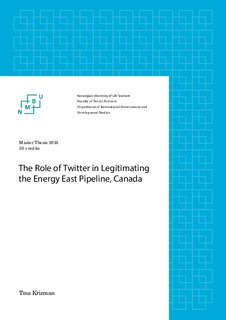| dc.contributor.advisor | McNeish, John A. | |
| dc.contributor.author | Krizman, Tina | |
| dc.coverage.spatial | Canada | nb_NO |
| dc.date.accessioned | 2016-11-23T08:24:11Z | |
| dc.date.available | 2016-11-23T08:24:11Z | |
| dc.date.issued | 2016-11-23 | |
| dc.identifier.uri | http://hdl.handle.net/11250/2422596 | |
| dc.description.abstract | This thesis explores the value of social media in contemporary democratic practices; more precisely, on the use of social media in Canadian tar-sands pipeline infrastructure debate through the lens of public sphere theory. The study aims to contribute to improved understanding of Twitter’s shaping the course of the proposed Energy East pipeline, its legitimacy and formation of public debate around it. It is based on a mixed-methods approach employing both qualitative and quantitative research methodology. Data was collected from a topic-specific content stream on Twitter, followed by a series of semi-structured interviews with some of the most influential users within a sample of collected tweets. The study identified the users, the content and socio-political context of tweets that are posted in connection with the pipeline as well as users’ perceptions of Twitter as a tool for online deliberative democratic practices.
Findings indicate Twitter is praised for offering an enabling environment for citizen journalism on real-time events, its swiftness of information dissemination, enabling contact with individuals outside of users’ established social circles and the power to influence public opinion. However, the medium is not without limitations which diminish its role as an optimal tool for democratic online public deliberation. My study suggests the main hindrance for this is the absence of constructive debate due to Twitter’s character-limitation of posts and predominantly one-sided communicative processes that take place within this medium. Its role in Energy East debate remains constrained within informative and reactive aspects of its service on current developments on the pipeline polemics and has as such a limited influence on legitimation processes surrounding the project. I therefore conclude that Twitter represents only a fragment of what can be considered the new public sphere and definitely not one-size-fits-all solution to the contemporary legitimation crisis of proposed large-scale industrial projects such as Energy East pipeline. | nb_NO |
| dc.language.iso | eng | nb_NO |
| dc.publisher | Norwegian University of Life Sciences, Ås | |
| dc.rights | Navngivelse-Ikkekommersiell-IngenBearbeidelse 3.0 Norge | * |
| dc.rights.uri | http://creativecommons.org/licenses/by-nc-nd/3.0/no/ | * |
| dc.subject | social media | nb_NO |
| dc.subject | Twitter | nb_NO |
| dc.subject | public opinion | nb_NO |
| dc.subject | deliberative democracy | nb_NO |
| dc.subject | legitimation | nb_NO |
| dc.subject | tar-sands | nb_NO |
| dc.subject | Energy East Pipeline | nb_NO |
| dc.subject | Canada | nb_NO |
| dc.title | The role of Twitter in legitimating the Energy East Pipeline, Canada | nb_NO |
| dc.type | Master thesis | nb_NO |
| dc.subject.nsi | VDP::Social science: 200 | nb_NO |
| dc.source.pagenumber | 112 | nb_NO |
| dc.description.localcode | M-IES | nb_NO |

